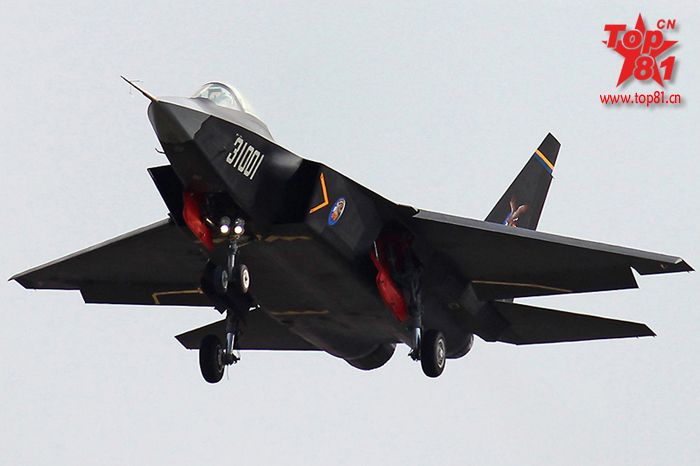

The J-31 continues flight testing at a Shenyang Aircraft Corporation research facility in northern China. As China’s second fifth generation fighter, the J-31 makes China the second nation in the world, after the United States, to have flown two fifth generation fighters. With a length of about 17 meters and an 11.5m wingspan, the J-31 is about the size of the F-35 Lightning II and smaller than the F-22, J-20 and PAK-FA. A large model of the J-31, designated as “F-60”, appeared at the Zhuhai 2012 Airshow, indicating a Chinese willingness to export the J-31 as a international competitor to the F-35. Once it enters service, the J-31 is likely to be serve alongside less numerous J-20s as part of a “high/low” combination, similar to the F-35/F-22 mix in the US Air Force. The J-31 is also likely to serve aboard future Chinese aircraft carriers, greatly enhancing their capabilities. Pakistan is likely to be the first export customer for the J-31, as Islamabad hopes to counter the Indian purchase of Russian FGFA stealth fighters.

The J-31 “Gyrfalcon” stealth fighter reportedly uses technology from the J-19, Shenyang’s failed bid for the Chinese heavy 5th generation fighter (which the Chengdu J-20 won). The J-31 has conducted at least six test flights in Shenyang since fall 2012 and a second prototype is under assembly. Compared to censorship of some J-20 photos, there is less secrecy about the J-31’s development.
To save weight, the J-31 uses an immense number of of 3D laser printed components, including titanium wing spars. Compared to the F-35, the J-31 uses two smaller Russian RD-33 engines instead of a larger engine like the AL-31 or WS-10. This gives the J-31 a flatter fuselage than the F-35; which suggests a more pronounced air superiority focus for the J-31, since a flatter fuselage results in a smaller weapons bay but improves fuel efficiency and speed by decreasing drag. It is likely that the J-31 could carry larger missiles like the YJ-12 anti-ship missile under its wings, but like with the F-35, at the cost of stealth. Vladimir Barkovsky, chief of the Russian MiG aircraft design bureau, has praised the J-31 as a “well done indigenous design” and “good machine” resulting from China’s ambitious aviation industry.
[Russian Officials Reveal J-31 Engines and Describe China Sales](https://The/ J-31 continues flight testing at a Shenyang Aircraft Corporation research facility in northern China. As China’s second fifth generation fighter, the J-31 makes China the second nation in the world, after the United States, to have flown two fifth generation fighters. With a length of about 17 meters and an 11.5m wingspan, the J-31 is about the size of the F-35 Lightning II and smaller than the F-22, J-20 and PAK-FA. A large model of the J-31, designated as “F-60”, appeared at the Zhuhai 2012 Airshow, indicating a Chinese willingness to export the J-31 as a international competitor to the F-35. Once it enters service, the J-31 is likely to be serve alongside less numerous J-20s as part of a “high/low” combination, similar to the F-35/F-22 mix in the US Air Force. The J-31 is also likely to serve aboard future Chinese aircraft carriers, greatly enhancing their capabilities. Pakistan is likely to be the first export customer for the J-31, as Islamabad hopes to counter the Indian purchase of Russian FGFA stealth fighters. The J-31 “Gyrfalcon” stealth fighter reportedly uses technology from the J-19, Shenyang’s failed bid for the Chinese heavy 5th generation fighter (which the Chengdu J-20 won). The J-31 has conducted at least six test flights in Shenyang since fall 2012 and a second prototype is under assembly. Compared to censorship of some J-20 photos, there is less secrecy about the J-31’s development. To save weight, the J-31 uses an immense number of of 3D laser printed components, including titanium wing spars. Compared to the F-35, the J-31 uses two smaller Russian RD-33 engines instead of a larger engine like the AL-31 or WS-10. This gives the J-31 a flatter fuselage than the F-35; which suggests a more pronounced air superiority focus for the J-31, since a flatter fuselage results in a smaller weapons bay but improves fuel efficiency and speed by decreasing drag. It is likely that the J-31 could carry larger missiles like the YJ-12 anti-ship missile under its wings, but like with the F-35, at the cost of stealth. Vladimir Barkovsky, chief of the Russian MiG aircraft design bureau, has praised the J-31 as a “well done indigenous design” and “good machine” resulting from China’s ambitious aviation industry. https://www.ainonline.com/aviation-news/ain-defense-perspective/2012-11-23/russian-officials-reveal-j-31-engine-and-describe-sales-china/)
